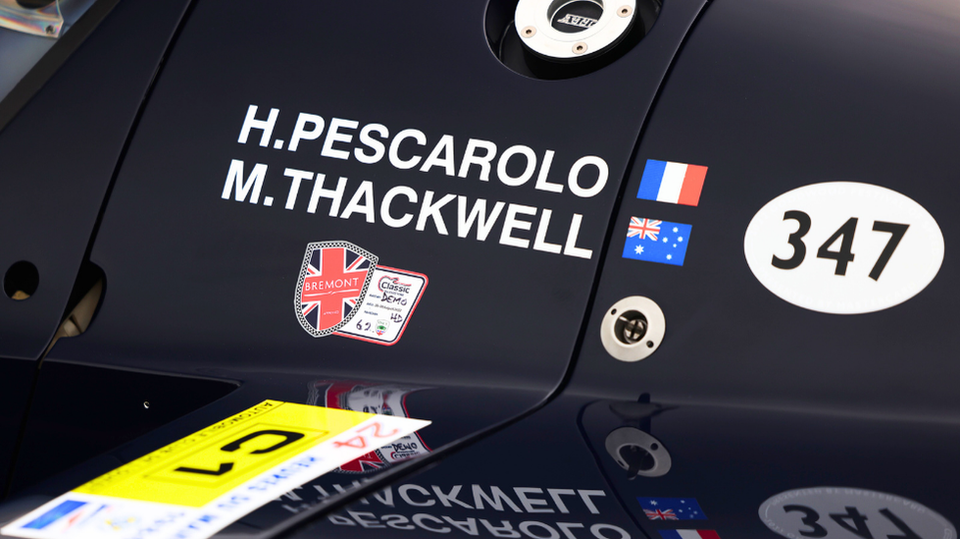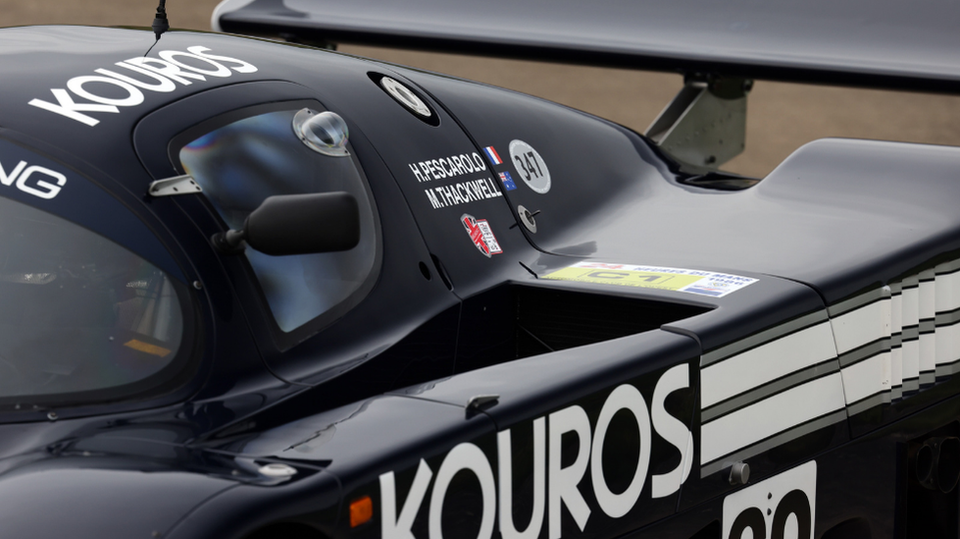
1986 SAUBER C8 MERCEDES
-
The most successful of the three Sauber C8s built - three times in the Le Mans 24 Hours
-
Winner of the 1986 Nürburgring 1000 km race driven by Mike Thackwell and legend Henri Pescarolo
-
Sponsored by Yves Saint Laurent
-
5-litre twin-turbo MERCEDES engine, torquey, powerful and reliable
-
Restored by XTEC Engineering
-
Eligible for the most prestigious events: Dubai GP Revival, Goodwood Festival of Speed, Daytona Classic 24 Hours, Rolex Monterey Motorsports Reunion, Masters Historic Racing, Silverstone Classic, Group C Racing & Le Mans Classic
Brand
SAUBER
Model
C8
Year
1986
Chassis number
86.C8.02
Chassis
ALUMINUM MONOCOQUE
Body
FIBERGLASS AND KEVLAR
Engine
MERCEDES 4,973 LITERS BI TURBO
Power
700 HP @ 7000 rpm
Gearbox
HEWLAND 5 SPEED
Weight
870 KG
ELIGIBILITY
TECHNICAL CHARACTERISTICS
LE MANS CLASSIC
GROUP C RACING
MASTERS HISTORIC RACING
DUBAI GP REVIVAL
SEBRING CLASSIC 12 HOUR by HSR
DAYTONA CLASSIC 24 HOUR by HSR
ROLEX MONTEREY MOTORSPOSTS REUNION
GOODWOOD FESTIVAL OF SPEED

Sponsored by Yves Saint Laurent, this Mercedes-powered Group C paved the way for Mercedes' one-two finish at Le Mans in 1989.
In 1985, the Sauber C8 was unveiled at the 24 Hours of Le Mans as a Group C prototype. It was the first prototype to result from a true partnership between Sauber and Mercedes-Benz.
Ascott Collection is particularly proud to offer this Sauber C8 chassis 86.C8.02 for sale as it plays an important role in the history of Sauber and Mercedes, two major companies in the sector that are still present in Formula 1 today. With only three cars produced, this Sauber C8 86.C8.02 is the most emblematic C8 of the brand: a car entrusted to Mike Thackwell and the legend Henri Pescarolo, it won the 1000 km of the Nürburgring and participated three times in the 24 Hours of Le Mans.
From the first creations to the C8 in partnership with Mercedes-Benz
The story of the Sauber C8 began long before the 1980s. In 1969, Peter Sauber, a passionate craftsman from Hinwil near Zurich, started building sports cars. After his first hill-climbing buggy, followed by the C1 Spyder with a Brabham-Hart 1000cc engine, he developed the C2, C3 and C4 with a Ford Cosworth engine for circuit racing.
Sauber made its debut at the 24 Hours of Le Mans with the C5, powered by the BMW M12 engine. Complying with Group 6 rules, the C5 raced at the Sarthe in 1977 and 1978, retiring and finishing 18th but unclassified. Sauber then moved up to Group C with the C6. The year was 1982 and Sauber was already involved in the new category that would dominate endurance racing for the next decade.
The C6, known as the SHS C6 because it was jointly developed by Sauber and Seger & Hoffman, suffered from vibration problems with its 3.9-litre Cosworth DFL V8 engine. This led to a switch to the BMW block for the C7 (1983). The C7 became famous for finishing 9th in the 1983 24 Hours of Le Mans, preventing Porsche from finishing in the top 10 overall! A fine performance, despite the fact that its BMW engine was less powerful than Porsche's...
Mercedes takes its first steps in Group C
In order to optimise the aerodynamics of his new creation (he could not find more power in his BMW block), Peter Sauber asked Mercedes-Benz to use their wind tunnel. This request led to a historic collaboration! The German manufacturer offered Sauber the use of the M117 engine, a 5-litre V8.
Sauber saw this as an opportunity to have a 'unique' engine and avoid the overly conventional Porsche engines. For Mercedes, on the other hand, it was an opportunity to 'test' Group C, which their rival Porsche and many other manufacturers were entering. The Mercedes-Benz block thus passed through the hands of Heini Mader (who acted as a 'cover') to keep the rumours of Mercedes' official return to competition under wraps. It was then installed in the new Sauber.
The Sauber C8, with Mercedes-Benz behind the scenes
Thus was born the Sauber C8, a natural evolution of the C7, designed by Sauber and his team to be powered exclusively by the Mercedes-Benz M117 block.
The new car represented a major technological leap forward. Its aluminium monocoque chassis was fitted with a Kevlar-reinforced fibreglass body designed by Peter Faul. But it was the engine that was the real revolution: the Mercedes V8 was fitted with two KKK turbochargers and developed the power the whole team had been working on for years (650 hp at 6,000 rpm in the race, with the possibility of 800 hp in qualifying). The engine, with its linerless aluminium block, featured Bosch Motronic 1.2 electronic management, similar to that of its main rival, the Porsche 962. The newly developed twin-turbo V8 was mated to a five-speed Hewland gearbox. Finally, Sauber had a complete package capable of taking on the Porsches.
As early as 1985, Mercedes-Benz sent consulting engineers to every test session. Rumours of an official return to endurance racing began to circulate.
Daimler-Benz quickly brought in money and sponsors, continued to develop the twin-turbo engine and finally helped to make the Hewland VGC gearbox more reliable with the help of British company Staffs Silent Gear Ltd.
The C8 heralded a new era for Sauber. The small company, which had only six full-time employees when engineer Leo Ress joined in 1985, grew.
The C8 got off to a spectacular start, although on its first appearance at the 24 Hours of Le Mans in 1985, John Nielsen went airborne during testing due to a flat-bottom problem.
So much for the official version. But with a very aggressive and extreme aerodynamic design (the C8 recorded the second best top speed in testing), it was undoubtedly the original concept, taken too far, that was at the root of this accident. Chassis 01 was repaired and repainted before the race, but will not race for the rest of the season.
The 86.C8.02 chassis offered for sale was produced in 1986. It won the Nürburgring 1000 km race, driven by Mike Thackwell and Henri Pescarolo.
Despite this difficult start, Mercedes decided to support Peter Sauber in his European programme. In 1986, the team received financial support from fashion designer Yves Saint-Laurent, who wanted to promote Kouros perfumes. The construction of two more chassis, chassis 02 and 03, was completed in time for the new 1986 campaign.
Now driven by big names such as Mike Thackwell and Henri Pescarolo in chassis 2, the C8 established itself as a serious contender in 1986. Victory came at the 1000 km Nürburgring. Mike Thackwell excelled on Goodyear wet tyres at the German circuit. A Mercedes engine had not won in a sports prototype since 1955 with the famous 300 SLR. Pescarolo and Thackwell often finished in the points in 1986, with 8th and 9th place finishes.
At the end of the 1986 season as an official car, 86.C8.02 continued its career with the Noël Del Bello Racing team and was entered in the 1987 and 1988 Le Mans 24 Hours.
Noël Del Bello was to drive the Sauber C8, which had won at the Nürburgring and twice at the 24 Hours of Le Mans, himself at the wheel in Sarthe. The adventure was not a success due to the C9s (in particular), the lack of support from Mercedes and the lack of high-profile drivers. The car was not entered again until midway through the 1988 season, when del Bello switched to a Tiga GC289 in the C2 category.
Acquired by the current owner from the Manfredo Lippman collection, it has been fully restored and returned to the track.
Sold by Noel Del Bello to the Mitsubishi Museum in Japan, this C8 Kouros was later owned by Manfredo Lippman in the USA. After his death, it was acquired in 2015 by its current owner, imported to Europe and entrusted to the British workshop XTEC Engineering, renowned for the quality of its work and its engines.
After a complete restoration, including the engine and gearbox, it was entered in two Group C Racing races by Peter Auto: Esperitu de Montjuic (Barcelona) & Monza Historic by Peter Auto in 2019.
In June 2022, it will be invited to the Goodwood Festival of Speed, where the roar of its powerful Mercedes engine will delight the public.
There will be plenty of opportunities to race this fabulous Group C in 2025, with Masters Historic launching a Group C series and Peter auto announcing a tempting programme including Le Mans Classic.. The most iconic Sauber C8, offered for the first time in a decade, offers a unique opportunity to own a legendary Group C with an iconic livery and a legendary engine.
Photos credit: Jakob Ebrey for Ascott Collection



























